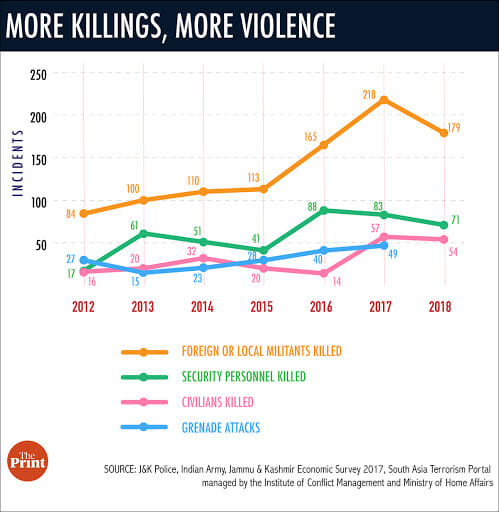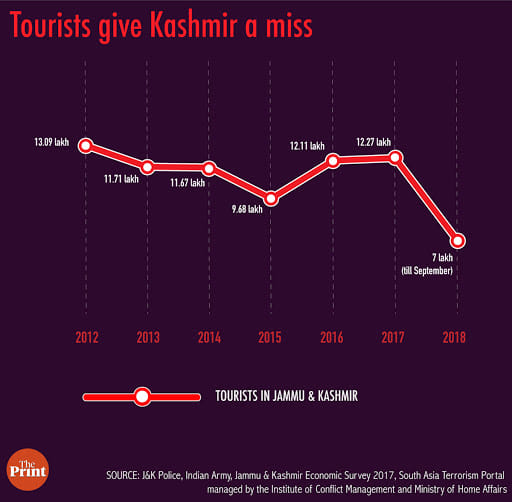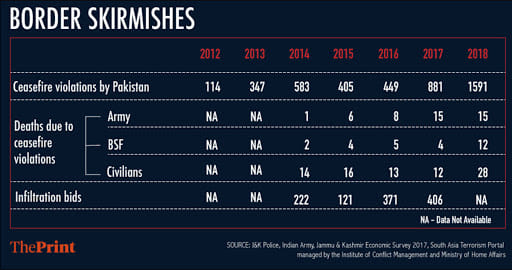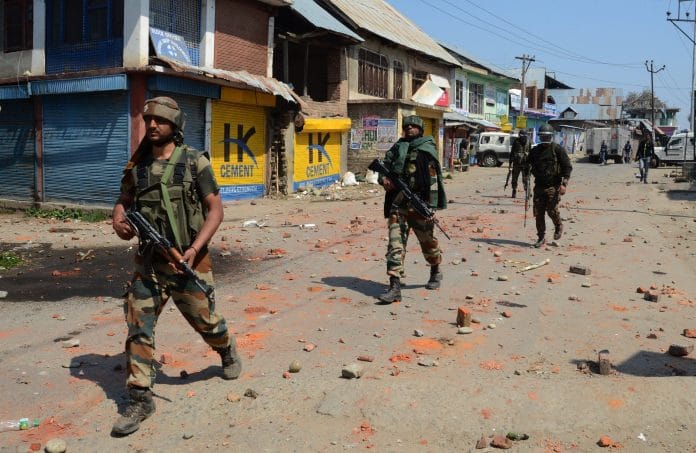Since the Narendra Modi-led BJP came to power at the Centre in 2014, Kashmir has witnessed more violence, deaths and alienation of the masses.
New Delhi: Last month, Firdousa was at home in Shadimarg village in south Kashmir, awaiting the birth of her third child, which was due in about three months. Now, Firdousa and her unborn child lie buried in a nearby graveyard, leaving behind a grieving husband and two distraught children.
Firdousa was killed in a cross-fire outside her home in Pulwama district on 19 October, another victim of the rising violence in the Valley.
Cold, hard numbers show that since the Narendra Modi-led BJP came to power at the Centre in 2014, there has been a 70 per cent rise in civilian deaths. There have also been sharp increases in violence, killings, and the feeling of alienation among the masses. The space for mainstream politics has shrunk, and border skirmishes have hit a new high.
Worrying numbers
The overall number of killings — including civilians, security forces personnel, policemen and militants — has almost tripled from 117 in 2012 to 304 so far this year.

The number of civilians killed has more than tripled in these six years; the number of security personnel killed has quadrupled. Among these personnel, the number of policemen being killed has shown the steepest increase — from four in 2012 to 43 and counting this year.
The growing trend of grenade attacks in the Valley has risen from 27 in 2012 to 49 in 2017.
All this seems to have had an adverse impact on tourism in Kashmir — from 13.09 lakh visitors in 2012, the number nosedived to just 7 lakh until September this year, with not much time left for an upswing in fortunes.

Meanwhile, the number of ceasefire violations by Pakistan has risen nearly 15-fold in the last six years, with 2018’s mark of 1,591 (so far) being almost double the number registered in 2017, which itself was almost double the violations in 2016.

Alienation
Academic Radha Kumar, who was part of the Dileep Padgaonkar-led interlocutor panel for Kashmir formed in 2010, told ThePrint that the situation had indeed got out of hand.
“The armed militancy is back, and so is the alienation and the anger. There is popular support (for the militants), not only through mass funerals, but people coming to try and block security forces’ operations,” Kumar said.
“It doesn’t help that you have Governor’s Rule. You have the suspended assembly. You have very little insight and no peace initiative. No attempts to have talks.
“There is no doubt that Kashmir has slipped out of hand, but there are many reasons for it. The time at which we were appointed (after violent protests and riots in 2010) was also very bad. But there is something exponentially wrong about the situation now.”
Also read: Come, kill us: Facebook post tears into killers of Kashmir cop who was an ‘obedient son’
The state’s former director general of police, Shesh Paul Vaid, concurred on the point of alienation.
“When the national media portrays every Kashmiri as anti-national, it alienates people of the Valley. When Kashmiris studying outside are attacked, it leads to alienation. If media picks up one problem and portrays it in certain way, it alienates the youth,” said Vaid.
Character of militancy
Unlike in the 1990s, this wave of local militancy is being fed by social media, said Vaid. Hizbul Mujahideen commander Burhan Wani used it to pose with guns in several viral pictures and videos. After Wani was killed in an encounter in 2016, educated young men picked up guns without taking any formal training.
“After Burhan Wani, social media was misused extensively from across the border to radicalise the youth. Alienation is also a contributing factor. Now, it is happening at a bigger scale,” Vaid told ThePrint.
A day before the panchayat polls, Hizbul Mujahideen released a chilling video – the first of its kind – showing militants killing a youth they believed was an Army informer.
The video, which has gone viral, showed militants pumping several rounds of bullets into Nadeem Manzoor of Pulwama. His body was recovered Friday morning.
The killing has been widely condemned and the video has been compared to ‘ISIS -style” on social media. Former chief minister Omar Abdullah called it “cold blooded murder”.
Another teenager was killed brutally on polling day on Saturday.
Militants had abducted three civilians in the morning and one of them identified as Huzaif, a baker, was killed with his throat slit.
When the PDP-BJP government was ruling the state, security forces announced a “soft approach” towards militants — according to Vaid, about 70 boys were prevented from joining the militancy and 20-odd surrendered.
However, Vaid himself was transferred and replaced as J&K DGP by Dilbagh Singh after militants demanded a quid pro quo, kidnapping policemen’s kin to secure the release of Hizbul Mujahideen commander Riyaz Naikoo’s father.
A top police officer in the J&K Police said the recruitment of militants had dropped significantly in the last two months. “This year, the total number of local militants killed is around 96 so far. The number of commanders killed is also much higher,” the officer said.
No-show at the polls
The last J&K assembly elections were held in the winter of 2014, about six months after the Lok Sabha polls that brought the BJP to power at the Centre. The Valley was devastated after massive flooding in September that year, and yet, a staggering 66 per cent of voters exercised their franchise.
Contrast that with the numbers registered during the recent urban local body (ULB) polls — the Kashmir Valley saw turnouts of 8.3, 3.4, 3.49 and 4.2 per cent in the four phases respectively. The overall voting percentage for the state, including the Jammu and Ladakh regions, was just 35.1 per cent.
The state’s oldest mainstream political party, the National Conference, has blamed former chief minister Mehbooba Mufti of the rival Peoples Democratic Party for being “insensitive” to the people during her coalition government with the BJP, which it believes has resulted in this alienation of the people.
NC spokesperson Tanvir Sadiq said Mehbooba relied so much on New Delhi that the state was “run by the Centre”, not her.
Party chief Omar Abdullah also blamed the now-defunct PDP-BJP alliance, and said the country needs to question Prime Minister Narendra Modi for mishandling the state.
“It is something that Prime Minister Narendra Modi will have to be made answerable for. You inherited a state where elections were regularly held on time and with people’s participation,” Abdullah had told ThePrint in an interview.
Incidentally, the PDP and the NC both boycotted the ULB polls, with Mehbooba going as far as to say that people who participated in these elections were “rogue elements” lured by money.
Her former partner BJP claimed victory in these polls because, for the first time, it won 100 local body seats in the Kashmir Valley. However, the numbers told a different story — 76 of these seats featured no contest at all, while in two seats, even its own candidates stayed away from the polling booths.
On its part, the BJP blamed every political party to have held power before it for “appeasement policies”.
“It is because of the previous governments and their appeasement policies that militancy increased. It is because of them the Kashmiri Pandits had to leave,” said former deputy chief minister and BJP leader Kavinder Gupta.
Asked about the low turnout in the ULB polls, Gupta insisted on looking at the proverbial bright side. “For the first time, elections were held so peacefully. We are hoping more people will participate in the panchayat elections in November,” he said.
Broken promises
In 2014, while the Modi wave was sweeping through large swathes of the country, people in Muslim-majority Kashmir were wary of “saffron forces”. The BJP used the Hindu-versus-Muslim ploy in the Hindu-majority Jammu region, and people flocked to vote for it.
Mehbooba, on the other hand, asked for a pro-PDP vote in the Valley to keep the BJP away from state politics in the assembly polls later that year. She pinned many wrongs — such as the killing of young boys and the use of pellets during the 2010 unrest — on Omar Abdullah’s incumbent government.
No one at the time could’ve guessed that the PDP would give the BJP a taste of power for the first time in Jammu and Kashmir. In fact, Mehbooba, whose late father Mufti Mohammad Sayeed forged the alliance with the BJP in 2015, said: “Mufti sahib took a very tough and unpopular decision to align with the BJP only to create (an) atmosphere of reconciliation and dialogue.” However, she said the attempt to recreate some of former PM Atal Bihari Vajpayee’s magic had failed, because “Modi is no Vajpayee”.
The parties’ ‘Agenda of Alliance’ — a common minimum programme they were supposed to work towards — is virtually a lost document.
However, BJP’s Gupta blamed the break-up on the PDP. “We made the government with PDP respecting the mandate we got and based it on governance. But the moment they began running government on their whims, we decided to withdraw,” he said.
On the financial front, Prime Minister Modi’s first address in Kashmir, at Srinagar’s Sher-e-Kashmir Cricket Stadium in November 2015, saw the announcement of a mega financial package of Rs 80,000 crore for the state. However, this package was for specific projects.
Fast-forward three years, and the man in charge of J&K, new governor Satya Pal Malik, says many other projects are stuck due to a lack of money, and that the government has had to borrow Rs 8,000 crore in bank loans.
“We have made a list of projects stuck due to lack of money. We have made a development corporation and picked up Rs 8,000 crore from banks. In six months, you will see a different Kashmir,” Malik insisted.
‘Excessive’ force
Many politicians and pundits have referred to the central government’s approach towards Kashmir as “muscular”, but the BJP’s Gupta rubbishes these claims.
“There is no such thing called ‘muscular’ policy. Our security forces show full restraint,” he said.
Yet, civilians continue to allege the use of excessive force by security personnel.
The use of pellets has allegedly led to a generation of blinded youngsters — the state human rights commission’s own statistics say there are over 2,000 pellet victims currently in J&K.
Then, there are cordon and search operations (CASO) across the Valley, mostly in residential areas, which are allegedly followed by encounters and killings.
The Army denies such allegations, with defence spokesperson Rajesh Kalia saying its policy is to give local militants the chance to surrender. However, if the militants refuse to budge, the encounter takes place, which leads to damage to property.
According to official data accessed by IndiaSpend, in south Kashmir’s Pulwama district alone, at least 105 homes were destroyed during gunfights between 2015 and March 2018.
Hurriyat and Pakistan
In October last year, the Centre appointed a new interlocutor for Kashmir, former Intelligence Bureau chief Dineshwar Sharma. He said he had the mandate to talk to anybody in Kashmir, including the Hurriyat Conference.
However, Sharma has since met only one Hurriyat leader, Prof. Abdul Gani Bhat, although he has visited all three regions of the state and met various civil society delegations, including youth.
The sticking point is the Hurriyat’s demand to include all stakeholders, including Pakistan, and transparency and a clear agenda from New Delhi.
BJP’s Gupta said there was no need to speak to Hurriyat or Pakistan. “Why should we talk to Pakistan and about what? Kashmir belongs to us and the part which Pakistan has occupied also belongs to us,” he said.
Governor Malik, meanwhile, said the Hurriyat were “important players”, but their insistence on bringing Pakistan to the discussion table had to be discarded.
“I respect Hurriyat leaders and think they are important players. My contention is that they say ‘talk to Pakistan’, which should not be the case. Pakistan is no stakeholder; it is a troublemaker. We think talks with Hurriyat are separate, while we will deal with Pakistan separately,” he said.
Also read: Militant snipers add grisly new chapter to Kashmir insurgency with three kills
What is the solution?
Asked what the solution to this worsening crisis was, Radha Kumar said there was no other way but dialogue and reconciliation.
Vaid stressed that a “whole government” approach was needed to bring the situation under control.
“It has to be fought on multiple fronts. It needs a whole government approach, not just leaving things to the security forces. Everyone, including the state and the Centre, has to play a role,” said Vaid.
NC’s Omar Abdullah put the onus to find the solution on those in power — the state governor, the National Security Advisor, the Prime Minister and the Home Minister.
“They need to first be able to accept that there is something wrong. You need to first diagnose the problem and then treat it. In this case, they are living in denial about the very existence of problem,” he said.
PDP’s Mehbooba, on the other hand, advocated a more neighbourly approach towards Pakistan.
“India has to learn to accept Pakistan as a country, as was done by Vajpayee. We need to work on these similarities rather than contradictions, and build a relationship of if not friends, at least normal neighbours… which will change the atmosphere here in the Valley.
“All this has to be followed by other confidence building measures on the ground, like less crackdowns and ending other means of harassment of people.”
This report has been updated 18 November with the viral video of killing of a teenager.







My tears have stopped flowing for Kashmir. Now, after a decade, ethnic violence has made a comeback in Assam. Punjab, saved for India at such high human cost, is feeling tremors after a generation. India is not a placid, settled land. The tectonic plates on which our nationhood rests are still moving. It required vision, statesmanship, a Nehruvian view of the world to hold it all together. If, instead, we begin to stir the pot, light small fires, no one can predict how it will all end.
Mr Modi came with an image of being heavily anti-Muslim, rightly or wrongly because of Gujarat, and he did nothing to correct that perception. As an individual he was not obliged to, but as the prime minister of a secular country, he was expected to. That is at the bottom of increase in Entropy or restlessness in Kashmir. It may be his arrogance, or lack of imagination or both, the truth of the matter is that he has not the foggiest idea of how to go about the problem of Kashmir. Kashmiri people are weak, Pakistan is weak, Modi is in a strong position, but instead of stepping forward like a strong man and calling out to weak people to pep them up and encourage and assuage them and create an atmosphere for positive talks conducive for peace, he has disconnected his telephone lines and is hiding behind a strong army. Who will call him a strong leader? Or even a leader, to begin with, seeping his other haphazard actions?
This is a very detailed article and the author must be congratulated for it. It has all the rigors of academic research, with graphs etc, and perhaps is a part of her M.Phil thesis or something like that! But as for the Kashmir problem itself, I get an eerie feeling that it is only TWO STEPS away from spinning completely out of India’s control.
Whose mistake congres bjp people of kashmir valley or pakistan whose mistake??????????????????????????????????????????????????? reporter technically vichar kare.